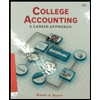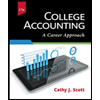
FIN.ACCT-TOOLS F/DECI.MAKERS-TEXT+WILEY+
9th Edition
ISBN: 9781119598312
Author: Kimmel
Publisher: WILEY C
expand_more
expand_more
format_list_bulleted
Question
Chapter 3, Problem 3.4DIE
To determine
Journal:
Journal is the method of recording monetary business transactions in chronological order. It records the debit and credit aspects of each transaction to abide by the double-entry system.
Rules of Debit and Credit:
Following rules are followed for debiting and crediting different accounts while they occur in business transactions:
- Debit, all increase in assets, expenses and dividends, all decrease in liabilities, revenues and
stockholders’ equities . - Credit, all increase in liabilities, revenues, and stockholders’ equities, all decrease in assets, expenses.
Ledger Account:
Ledger is an accounting book which facilitates the transfer of all journal entries in a chronological order to individual accounts.
Posting:
Posting is the procedure of transferring
To post: the transaction to cash account of BD.
Expert Solution & Answer
Want to see the full answer?
Check out a sample textbook solution
Students have asked these similar questions
I need guidance with this financial accounting problem using the right financial principles.
I need the correct answer to this financial accounting problem using the standard accounting approach.
Provide answer with calculation accounting question
Chapter 3 Solutions
FIN.ACCT-TOOLS F/DECI.MAKERS-TEXT+WILEY+
Ch. 3 - Prob. 1QCh. 3 - Can a business enter into a transaction that...Ch. 3 - Are the followingevents recorded in the accounting...Ch. 3 - Prob. 4QCh. 3 - Prob. 5QCh. 3 - Prob. 6QCh. 3 - Prob. 7QCh. 3 - Misty Reno, a beginning accounting student,...Ch. 3 - Prob. 9QCh. 3 - What is the normal balance for each of these...
Ch. 3 - Prob. 11QCh. 3 - Prob. 12QCh. 3 - Prob. 13QCh. 3 - Prob. 14QCh. 3 - Prob. 15QCh. 3 - (a) When entering a transaction in the journal,...Ch. 3 - (a) Should accounting transaction debits and...Ch. 3 - Journalize these accounting transactions. (a)...Ch. 3 - Prob. 19QCh. 3 - Prob. 20QCh. 3 - Prob. 21QCh. 3 - Prob. 22QCh. 3 - Prob. 3.1BECh. 3 - For each of the following accounts, indicate the...Ch. 3 - Prob. 3.6BECh. 3 - Prob. 3.7BECh. 3 - Prob. 3.9BECh. 3 - Tilton Corporation has the following transactions...Ch. 3 - Prob. 3.11BECh. 3 - Selected transactions for Montes Company are...Ch. 3 - Prob. 3.1DIECh. 3 - Prob. 3.2DIECh. 3 - Prob. 3.3DIECh. 3 - Prob. 3.4DIECh. 3 - Prob. 3.1ECh. 3 - Prob. 3.6ECh. 3 - Prob. 3.7ECh. 3 - Prob. 3.8ECh. 3 - Prob. 3.9ECh. 3 - Prob. 3.10ECh. 3 - Prob. 3.11ECh. 3 - Prob. 3.12ECh. 3 - Prob. 3.15ECh. 3 - Prob. 3.20ECh. 3 - Prob. 3.23ECh. 3 - Prob. 3.1APCh. 3 - Prob. 3.4APCh. 3 - Prob. 3.11APCh. 3 - Prob. 3.2EYCTCh. 3 - Prob. 3.3EYCTCh. 3 - Prob. 3.4EYCTCh. 3 - Prob. 3.7EYCTCh. 3 - Prob. 3.8EYCTCh. 3 - Prob. 3.9EYCTCh. 3 - Prob. 3.11EYCTCh. 3 - Prob. 3.1IFRS
Knowledge Booster
Learn more about
Need a deep-dive on the concept behind this application? Look no further. Learn more about this topic, accounting and related others by exploring similar questions and additional content below.Similar questions
- Please provide the correct answer to this general accounting problem using valid calculations.arrow_forwardI need assistance with this general accounting question using appropriate principles.arrow_forwardCan you explain this financial accounting question using accurate calculation methods?arrow_forward
- In the first two years of operations, Expos company reports taxable income of $125,000 and $65,000, respectively. In the first two years, the company paid $50,000 and $13,000. It is now the end of the third year, and the company has a loss of $160,000 for tax purposes. The company carries losses to the earliest year possible. The tax rate is currently 25%. Required Compute the amount of income tax payable or receivable in the current (third) year.arrow_forwardFinancial Accountingarrow_forwardPlease give me true answer this financial accounting questionarrow_forward
- I need help with this financial accounting problem using proper accounting guidelines.arrow_forwardPlease explain the solution to this general accounting problem with accurate principles.arrow_forwardCan you solve this financial accounting problem with appropriate steps and explanations?arrow_forward
- Please provide the answer to this financial accounting question using the right approach.arrow_forwardOn January 1, 2024, Sunfish Co. issued a $22 million, 8%, 6-year convertible bond with annual coupon payments. Each $1,000 bond was convertible into 35 shares of Sunfish's common shares. Shark Investments purchased the entire bond issue for $22.7 million on January 1, 2024. Shark estimated that without the conversion feature, the bonds would have sold for $21,013,098 (to yield 9%). On January 1, 2025, Shark converted bonds with a par value of $8.8 million. At the time of conversion, the shares were selling at $30 each. Required Prepare the journal entry to record the issuance of convertible bonds. Prepare the journal entry to record the conversion according to IFRS (book value method). Prepare the journal entry to record the conversion according ASPE (market value method).arrow_forwardRoseBud Motel Ltd. (RM) had 100,000 ordinary shares outstanding during all of 2025, all owned by the owner Johnny Rose. In 2023, RM issued $500,000, 3% non-cumulative preferred shares. Each $100 preferred share is convertible into one ordinary share. RM also had 6,000, $100 cumulative preferred shares outstanding that are each entitled to an annual dividend of $1.60. Each preferred share is convertible into two ordinary shares. RM’s net income for the year ended December 31, 2025, was $400,000. Its income tax rate was 20%. The annual dividend was declared and paid during 2025 on the cumulative preferred shares but not on the non-cumulative shares. Required Calculate RM’s basic EPS for 2025. Are the non-cumulative convertible preferred shares dilutive or antidilutive in nature? The cumulative convertible preferred shares? Support your answer with calculations. Calculate RM’s diluted EPS for 2025.arrow_forward
arrow_back_ios
SEE MORE QUESTIONS
arrow_forward_ios
Recommended textbooks for you
- Principles of Accounting Volume 1AccountingISBN:9781947172685Author:OpenStaxPublisher:OpenStax College
 Financial AccountingAccountingISBN:9781337272124Author:Carl Warren, James M. Reeve, Jonathan DuchacPublisher:Cengage Learning
Financial AccountingAccountingISBN:9781337272124Author:Carl Warren, James M. Reeve, Jonathan DuchacPublisher:Cengage Learning College Accounting, Chapters 1-27AccountingISBN:9781337794756Author:HEINTZ, James A.Publisher:Cengage Learning,
College Accounting, Chapters 1-27AccountingISBN:9781337794756Author:HEINTZ, James A.Publisher:Cengage Learning,  College Accounting (Book Only): A Career ApproachAccountingISBN:9781305084087Author:Cathy J. ScottPublisher:Cengage LearningCentury 21 Accounting Multicolumn JournalAccountingISBN:9781337679503Author:GilbertsonPublisher:Cengage
College Accounting (Book Only): A Career ApproachAccountingISBN:9781305084087Author:Cathy J. ScottPublisher:Cengage LearningCentury 21 Accounting Multicolumn JournalAccountingISBN:9781337679503Author:GilbertsonPublisher:Cengage College Accounting (Book Only): A Career ApproachAccountingISBN:9781337280570Author:Scott, Cathy J.Publisher:South-Western College Pub
College Accounting (Book Only): A Career ApproachAccountingISBN:9781337280570Author:Scott, Cathy J.Publisher:South-Western College Pub

Principles of Accounting Volume 1
Accounting
ISBN:9781947172685
Author:OpenStax
Publisher:OpenStax College

Financial Accounting
Accounting
ISBN:9781337272124
Author:Carl Warren, James M. Reeve, Jonathan Duchac
Publisher:Cengage Learning

College Accounting, Chapters 1-27
Accounting
ISBN:9781337794756
Author:HEINTZ, James A.
Publisher:Cengage Learning,

College Accounting (Book Only): A Career Approach
Accounting
ISBN:9781305084087
Author:Cathy J. Scott
Publisher:Cengage Learning

Century 21 Accounting Multicolumn Journal
Accounting
ISBN:9781337679503
Author:Gilbertson
Publisher:Cengage

College Accounting (Book Only): A Career Approach
Accounting
ISBN:9781337280570
Author:Scott, Cathy J.
Publisher:South-Western College Pub
IAS 29 Financial Reporting in Hyperinflationary Economies: Summary 2021; Author: Silvia of CPDbox;https://www.youtube.com/watch?v=55luVuTYLY8;License: Standard Youtube License